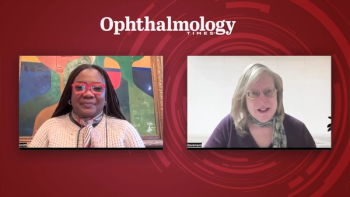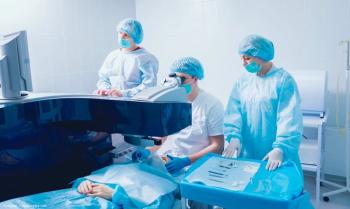
NSAID-prednisolone combo reduces post-cataract CME
Administration of nepafenac, a topical nonsteroidal anti-inflammatory drug, and prednisolone resulted in a significantly lower rate of pseudophakic macular edema following cataract surgery compared with the rate in patients who received only prednisolone.
Key Points
Vail, CO-Administration of a topical nonsteroidal anti-inflammatory drug (NSAID), nepafenac (Nevanac, Alcon Laboratories), and prednisolone resulted in a significantly lower rate of pseudophakic macular edema following cataract surgery compared with the rate in patients who received only prednisolone, according to Richard E. Braunstein, MD.
NSAIDs inhibit the cyclooxygenase pathway, which limits prostaglandin formation, a major cause of postoperative inflammation and cystoid macular edema (CME). Administration of both corticosteroids and NSAIDs provides synergistic activity that results in more rapid resolution of symptomatic CME, Dr. Braunstein explained. He reported his results at the Current Concepts in Ophthalmology meeting, Vail, CO. The meeting was sponsored by Johns Hopkins University School of Medicine, Baltimore, and Ophthalmology Times.
"CME, the most common cause of visual loss after uncomplicated cataract surgery, usually occurs 4 to 6 weeks postoperatively. Angiographic CME may occur in 20% to 30% of cases and clinical CME in 1% to 6.9%," he said. Dr. Braunstein is the Miranda Wong Tang Associate Professor of Clinical Ophthalmology and chief, Division of Anterior Segment, Edward S. Harkness Eye Institute, Columbia University Medical Center, New York.
Dr. Braunstein also cited an article by Weisz et al. that showed the benefit of ketorolac (Acular, Allergan), an NSAID, in the treatment of pseudophakic CME that developed more than 2 years after cataract surgery. In that study, 10 eyes of nine patients were treated following cataract surgery performed a mean of 59 months previously. After ketorolac therapy, seven of the eyes improved a mean of 3.2 lines of visual acuity, two eyes remained unchanged, and one eye worsened by one line of visual acuity.
Dr. Braunstein and colleagues conducted a study in which they evaluated the efficacy of nepafenac 0.1% suspension, the amide analog of the NSAID amfenac, in preventing pseudophakic macular edema. In that retrospective chart review of patients who had undergone cataract surgery, 240 patients were treated with prednisolone alone and 210 patients were treated with both prednisolone and nepafenac. Postoperatively, prednisolone was given four times a day for 1 week, three times a day for 1 week, twice daily for 1 week, and then every day for 1 week; nepafenac was given three times daily for 4 weeks. The patients also were given moxifloxacin four times daily for 8 days starting 1 day before the surgery.
The study endpoints were suboptimal Snellen visual acuity 1 month postoperatively, no substantial corneal disease or capsular opacification, and CME that was confirmed by optical coherence tomography (OCT).
All patients had undergone uncomplicated phacoemulsification with implantation of an IOL. All surgeries were performed by Dr. Braunstein, who used the same phaco machine (Infiniti, Alcon). No significant differences existed in the characteristics of the patients.
"The patients who had visually significant CME were the five who received only prednisolone after surgery. No patients who were given both nepafenac and prednisolone had visually significant CME," Dr. Braunstein reported. This result was statistically significant (p = 0.03).
No significant adverse events were seen in either of the groups. One patient who was initially in the nepafenac and prednisolone group was taken off of nepafenac because of a corneal epithelial defect. This patient later developed CME that was documented by OCT. This patient was not counted in the CME group.
The investigators concluded that patients who were treated with a postoperative regimen of concomitant prednisolone and nepafenac had a significantly lower incidence of pseudophakic CME than patients treated with prednisolone alone.
Dr. Braunstein pointed out that, in his practice, patients receive a topical corticosteroid that is tapered over 4 weeks. A topical NSAID is prescribed for 4 weeks for all patients who undergo cataract extraction; the NSAID is used cautiously in those patients with an underlying immune-mediated disease. Patients at high risk receive an NSAID for up to 8 weeks postoperatively.
Newsletter
Don’t miss out—get Ophthalmology Times updates on the latest clinical advancements and expert interviews, straight to your inbox.













































